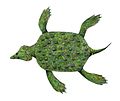| Nothosauroidea Temporal range: Early-Late Triassic, 251–210 Ma PreꞒ Ꞓ O S D C P T J K Pg N Possible late Rhaetian record. | |
|---|---|

| |
| Nothosaurus | |
| Scientific classification | |
| Domain: | Eukaryota |
| Kingdom: | Animalia |
| Phylum: | Chordata |
| Class: | Reptilia |
| Superorder: | †Sauropterygia |
| Clade: | †Eosauropterygia |
| Order: | †Nothosauroidea Baur, 1889 |
| Subgroups | |
| |
Nothosaurs (superfamily Nothosauroidea) were Triassic marine sauropterygian reptiles. They averaged about 3 metres (10 ft) in length, with a long body and tail. The feet were paddle-like, and are known to have been webbed in life, to help power the animal when swimming. The neck was quite long, and the head was elongated and flattened, and relatively small in relation to the body. The margins of the long jaws were equipped with numerous sharp outward-pointing teeth, indicating a diet of fish and squid.
Taxonomy
The Nothosauroidea has been suggested to consist of two suborders, the Pachypleurosauria, which are small primitive forms, and the Nothosauria (including two families Nothosauridae and Simosauridae), which may have evolved from pachypleurosaurs.
The relation of pachypleurosaurs to Nothosauroidea is uncertain, as several analyses recover the clade as basal to Eusauropterygia, e.i. the clade formed by Nothosauria and Pistosauroidea, instead as the sister taxon of Nothosauria. Many recent analyses have recovered the pachypleurosaurs as a basal clade of eosauropterygians outside of the nothosauroidea.
Nothosaur-like reptiles were in turn ancestral to the more completely marine plesiosaurs, which replaced them at the end of the Triassic period.
In their 2024 description of Dianmeisaurus mutaensis, Hu, Li & Liu recovered the Nothosauroidea as the sister taxon to the Pachypleurosauria. The results of their phylogenetic analyses are shown in the cladogram below:
| Sauropterygia |
| ||||||||||||||||||||||||||||||
-
 Keichousaurus (a pachypleurosaur)
Keichousaurus (a pachypleurosaur)
-
 Lariosaurus
Lariosaurus
-
 Ceresiosaurus
Ceresiosaurus
Distribution
A 2024 description of a fossil nothosaur vertebra from the Anisian of New Zealand indicates that nothosaurs dispersed worldwide from their region of origin in the northern Tethys much earlier than presumed, eventually reaching the southern polar region of Panthalassa by the Middle Triassic. This vertebra is the oldest sauropterygian fossil from the Southern Hemisphere, and appears to be from a taxon related to Nothosaurus and Lariosaurus.
References
- F. v. Huene. 1956. Paläontologie und Phylogenie der Niederen Tetrapoden . VEB Gustav Fischer Verlang, Jena 1-716
- Palmer, D., ed. (1999). The Marshall Illustrated Encyclopedia of Dinosaurs and Prehistoric Animals. London: Marshall Editions. p. 72. ISBN 978-1-84028-152-1.
- Olivier Rieppel (1999). "The sauropterygian genera Chinchenia, Kwangsisaurus, and Sanchiaosaurus from the Lower and Middle Triassic of China". Journal of Vertebrate Paleontology. 19 (2): 321–337. Bibcode:1999JVPal..19..321R. doi:10.1080/02724634.1999.10011144.
- Xu, G.-H.; Shang, Q.-H.; Wang, W.; Ren, Y.; Lei, H.; Liao, J.-L.; Zhao, L.-J.; Li, C. (2023). "A new long-snouted marine reptile from the Middle Triassic of China illuminates pachypleurosauroid evolution". Scientific Reports. 13 (1). 16. Bibcode:2023NatSR..13...16X. doi:10.1038/s41598-022-24930-y. ISSN 2045-2322. PMC 9816097. PMID 36604433.
- ^ Hu, Yi-Wei; Li, Qiang; Liu, Jun (2024-01-05). "A new pachypleurosaur (Reptilia: Sauropterygia) from the Middle Triassic of southwestern China and its phylogenetic and biogeographic implications". Swiss Journal of Palaeontology. 143 (1): 1. doi:10.1186/s13358-023-00292-4. ISSN 1664-2384.
- Kear, Benjamin P.; Roberts, Aubrey J.; Young, George; Terezow, Marianna; Mantle, Daniel J.; Barros, Isaias Santos; Hurum, Jørn H. (2024). "Oldest southern sauropterygian reveals early marine reptile globalization". Current Biology. 34 (12): R562 – R563. doi:10.1016/j.cub.2024.03.035. ISSN 0960-9822.
Sources
- Johnson, Jinny (2000). Fantastic Facts About Dinosaurs. Parragon. ISBN 978-0-7525-3166-3.
- Benton, M. J. (2004), Vertebrate Paleontology, 3rd ed. Blackwell Science Ltd classification
- Colbert, E. H., (1969), Evolution of the Vertebrates, John Wiley & Sons Inc (2nd ed.)
- Rieppel, O., (2000), Sauropterygia I, placodontia, pachypleurosauria, nothosauroidea, pistosauroidea: In: Handbuch der Palaoherpetologie, part 12A, 134pp. Verlag Dr. Friedrich Pfeil Table of contents
| Taxon identifiers | |
|---|---|
| Nothosauria | |
This article about a prehistoric reptile is a stub. You can help Misplaced Pages by expanding it. |






